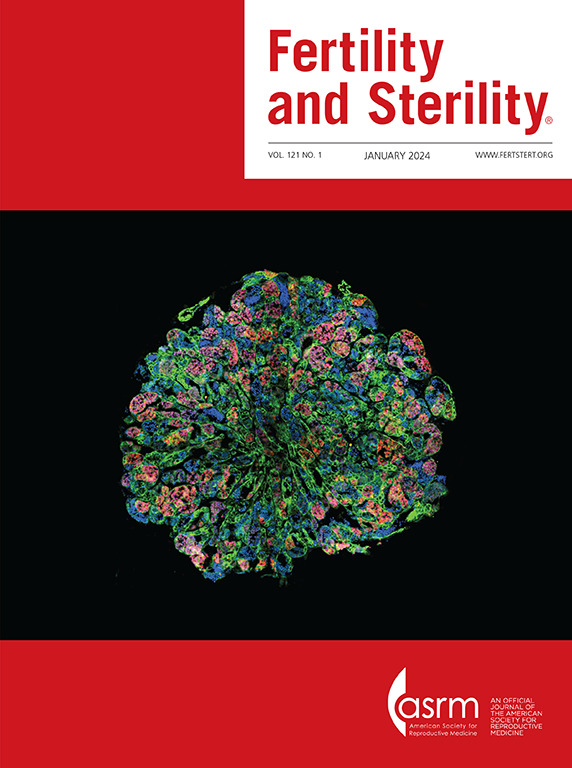GnRH antagonist protocol is associated with higher oocyte yield in young women at high risk for low oocyte retrieval: a retrospective study using three statistical methods.
IF 7
1区 医学
Q1 OBSTETRICS & GYNECOLOGY
引用次数: 0
Abstract
OBJECTIVE To study whether gonadotropin-releasing hormone (GnRH) antagonist protocol is associated with improved oocyte retrieval outcomes compared to progestin-primed ovarian stimulation (PPOS) protocol in young women at high predicted risk for low oocyte yield. DESIGN Retrospective cohort study applying Bayesian analysis before and after propensity score matching (PSM), and risk-based stratified subgroup analysis SUBJECTS: A total of 2,068 women aged ≤35 years undergoing their first IVF/ICSI cycle between January 2023 and April 2025, identified as high risk for low oocyte retrieval (predicted score ≥0.41) using a validated nomogram incorporating age, AMH, AFC, basal FSH, and FSH/LH ratio. EXPOSURE Ovarian stimulation with either a GnRH antagonist protocol or a PPOS protocol, with protocol selection based on clinical judgment and patient characteristics. MAIN OUTCOME MEASURES Incidence of low oocyte retrieval (<10 oocytes), and the number of oocytes retrieved. RESULTS Among 2,068 young women at high predicted risk for low oocyte yield, the GnRH antagonist protocol resulted in significantly better ovarian stimulation outcomes compared to the PPOS protocol. After PSM, the antagonist group had a higher mean number of oocytes retrieved (8.3 vs. 5.3; BF10 > 1028) and a higher oocyte retrieval rate (88.2% vs. 81.2%; BF10 > 103). The incidence of low oocyte retrieval (<10 oocytes) was significantly lower in the antagonist group (65.2% vs. 86.0%; BF10 > 1019). No significant differences were observed in embryo quality or fertilization rates. Risk-based stratified analysis showed that the GnRH antagonist protocol significantly reduced the incidence of low oocyte retrieval in low- to mid-risk groups (median OR 0.30-0.57, BF10 up to 647.8), while in the highest risk subgroup, PPOS showed a potential advantage. CONCLUSION The GnRH antagonist protocol is superior to PPOS in maximizing oocyte retrieval among young women at high predicted risk for poor ovarian response, highlighting the value of individualized risk-based stimulation strategies to improve clinical outcomes.GnRH拮抗剂方案与低卵母细胞回收高风险的年轻女性更高的卵母细胞产量相关:一项使用三种统计方法的回顾性研究。
目的研究促性腺激素释放激素(GnRH)拮抗剂方案与黄体酮刺激卵巢(PPOS)方案相比,在低卵母细胞产量高预测风险的年轻女性中,是否与改善的卵母细胞恢复结果相关。设计回顾性队列研究,在倾向评分匹配(PSM)前后应用贝叶斯分析和基于风险的分层亚组分析。研究对象:2023年1月至2025年4月期间接受第一次IVF/ICSI周期的2068名年龄≤35岁的女性,使用包含年龄、AMH、AFC、基础FSH和FSH/LH比值的有效nomogram,确定为低卵母细胞回收的高风险(预测评分≥0.41)。暴露卵巢刺激与GnRH拮抗剂方案或PPOS方案,方案的选择基于临床判断和患者的特点。主要观察指标:低卵母细胞回收率(1028)和高卵母细胞回收率(88.2% vs. 81.2%;[au:] [au:]卵母细胞回收率低(1019)。在胚胎质量和受精率方面没有观察到显著差异。基于风险的分层分析显示,GnRH拮抗剂方案显著降低了低至中危组的低卵母细胞回收发生率(中位OR为0.30-0.57,BF10高达647.8),而在高危亚组中,PPOS显示出潜在的优势。结论GnRH拮抗剂方案在卵巢反应不良的高风险年轻女性中最大限度地恢复卵母细胞方面优于PPOS,突出了个体化基于风险的刺激策略对改善临床结果的价值。
本文章由计算机程序翻译,如有差异,请以英文原文为准。
求助全文
约1分钟内获得全文
求助全文
来源期刊

Fertility and sterility
医学-妇产科学
CiteScore
11.30
自引率
6.00%
发文量
1446
审稿时长
31 days
期刊介绍:
Fertility and Sterility® is an international journal for obstetricians, gynecologists, reproductive endocrinologists, urologists, basic scientists and others who treat and investigate problems of infertility and human reproductive disorders. The journal publishes juried original scientific articles in clinical and laboratory research relevant to reproductive endocrinology, urology, andrology, physiology, immunology, genetics, contraception, and menopause. Fertility and Sterility® encourages and supports meaningful basic and clinical research, and facilitates and promotes excellence in professional education, in the field of reproductive medicine.
 求助内容:
求助内容: 应助结果提醒方式:
应助结果提醒方式:


